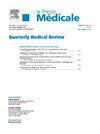急性肺栓塞的预后。
IF 3.4
3区 医学
Q1 MEDICINE, GENERAL & INTERNAL
引用次数: 0
摘要
对急性肺栓塞(PE)患者进行风险分层有助于选择适当的初始疗法和治疗环境。出现动脉低血压或休克的急性无症状肺栓塞患者死亡风险很高,治疗指南建议在这种情况下应重点考虑再灌注治疗。对于血流动力学稳定的 PE 患者,如果临床预后评分为阴性,且没有计算机断层扫描评估的右心室扩大,则可准确识别出那些在确诊 PE 后短期并发症风险较低的患者,这些患者可能会从缩短住院时间或门诊治疗中获益。一些证据表明,在标准抗凝治疗的情况下,显示 PE 后果较差的因素的累积可识别出病情较严重的稳定型急性 PE 患者,这些患者可能会从强化监测和再通程序中获益,尤其是在血流动力学恶化的情况下。目前的风险分类存在一些缺陷,可能会对临床和医疗决策产生不利影响。正在进行的计划旨在解决其中的许多缺陷,并有望帮助优化风险分层算法和治疗策略。本文章由计算机程序翻译,如有差异,请以英文原文为准。
Risk stratification of acute pulmonary embolism
Risk stratification of patients with acute pulmonary embolism (PE) assists with the selection of appropriate initial therapy and treatment setting. Patients with acute symptomatic PE that present with arterial hypotension or shock have a high risk of death, and treatment guidelines recommend strong consideration of reperfusion in this setting. For haemodynamically stable patients with PE, the combination of a negative clinical prognostic score and the absence of computed tomography-assessed right ventricle enlargement may accurately identify those at low-risk of short-term complications after the diagnosis of PE, and such patients might benefit from an abbreviated hospital stay or outpatient therapy. Some evidence suggests that the accumulation of factors indicating worse outcomes from PE on standard anticoagulation identifies the more severe stable patients with acute PE who might benefit from intensive monitoring and recanalization procedures, particularly if haemodynamic deterioration occurs. Current risk classifications have several shortcomings that might adversely affect clinical and healthcare decisions. Ongoing initiatives aim to address many of those shortcomings, and will hopefully help optimize risk stratification algorithms and treatment strategies.
求助全文
通过发布文献求助,成功后即可免费获取论文全文。
去求助
来源期刊

Presse Medicale
医学-医学:内科
自引率
3.70%
发文量
40
审稿时长
43 days
期刊介绍:
Seule revue médicale "généraliste" de haut niveau, La Presse Médicale est l''équivalent francophone des grandes revues anglosaxonnes de publication et de formation continue.
A raison d''un numéro par mois, La Presse Médicale vous offre une double approche éditoriale :
- des publications originales (articles originaux, revues systématiques, cas cliniques) soumises à double expertise, portant sur les avancées médicales les plus récentes ;
- une partie orientée vers la FMC, vous propose une mise à jour permanente et de haut niveau de vos connaissances, sous forme de dossiers thématiques et de mises au point dans les principales spécialités médicales, pour vous aider à optimiser votre formation.
 求助内容:
求助内容: 应助结果提醒方式:
应助结果提醒方式:


